Blog categories
Blog archive
RSS Blog posts tagged with 'tips'
Blog Filters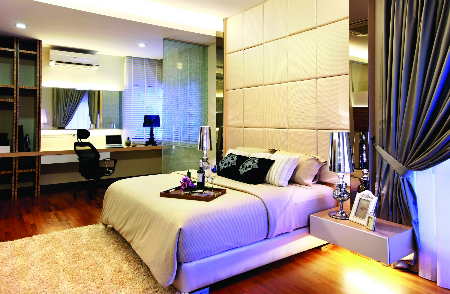
Enigmatic Bedrooms Decorated With Purple
Friday, November 20, 2020
From the sea snail shells found along the ancient Phoenician coastlines of Tyre to the togas of Roman senators, and on to as recent a time as Queen Elizabeth II’s coronation, the colour purple has been associated with mystery, power, royalty – and the height of bravery in the case of the Purple Heart. Despite the connotations, spaces painted in purple are relatively rare to come by – especially in this age of neutral-coloured interiors and compact spaces. But the results are undeniably awe-inspiring whether purple is applied as an accent or as a base colour. To illustrate the sensuous effects of purple – and perhaps to inspire you to try something different in the bedroom – we bring your attention to a selection of bedrooms brought to deeply soothing and enigmatic levels with the mere addition of violet-coloured light or materials.
Beguiling Accent
 Interior design by: Turn Design
Interior design by: Turn Design
Perhaps the very first and easiest thing to try when experimenting with purple, or any other bold shade, is to inject the colour with the aid of a lighting fixture. Utilising ultraviolet bulbs intended for water purification systems would not be recommended for health reasons – ultraviolet light of the UVB variety is a germ killer and equivalent to sunlight in terms of the damage it can cause – but "black-lights", UVA bulbs, or even regular bulbs tinted purple will provide a harmless wash of violet-coloured light. This equivalent of dipping one's toe into unfamiliar waters enables slight adjustments – leading to possible results such as the pictured bedroom decorated by Turn Design. The purple glow here serves as a tentative accent for the neutral-coloured space, delivered to the sunlit side of the bed via a pair of bedside lamps.
Absolute Saturation
 Interior design by: Space In Design
Interior design by: Space In Design
If the alluring quality of purple illumination has won you over, you may find yourself surprised by the delightful effects of a predominantly white room fully saturated in violet light. As demonstrated by Space In Design with the pictured bedroom, the architectural finishes of the walls and ceiling have been deliberately left featureless and white in order to extend the reach of purple light. The result is that all the plain white surfaces are rendered intriguing with a fluorescent sheen, while slivers of white and yellow illumination are used to segment the background and provide the space with a measure of visual depth.
Prominent Display
 Interior design by: Jashen Interior
Interior design by: Jashen Interior
If you are looking for more control over the introduction of bold shades like purple in the bedroom, consider utilising fabrics dyed in your prefered shade of violet instead of attempting to fine-tune the highly variable effects of lighting. As demonstrated by Jashen Interior in the pictured bedroom, the introduction of purple is done through carpeting and drapery in light and dark shades, securing the colour's place in the white space regardless of the quality of light. The net effect of this combination is one of mutual support – the white background brings attention to the purple accents while the various shades of violet lend the crisp white space a contour of uplifting opulence.
Background Flavour
 Interior design by: Surface R
Interior design by: Surface R
With some comfort in its balanced use, one could take the saturation of purple to the maximum by applying various shades of violet in architectural finishes. The result of painting both the walls and the decorative headboard in the same shade of purple is a cohesive background that is instantly soothing to the eye, as in the pictured bedroom designed by Surface R, while the contrasting of dark wood flooring and a sprinkling of neutral coloured planes against the purple background creates a space that simultaneously speaks of fun-loving vibes and regal poise.
Click here to read about decorating various spaces in white.
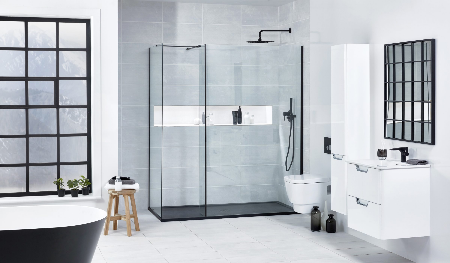
Minimalist Bathrooms’ Must-Have Features
Friday, November 20, 2020
Beyond slim profiles and unobtrusive colours, there are a host of characteristics expected to accompany the ubiquitous minimalist bathroom.
Born out of a reaction to abstract expressionism, minimalism continues to be highly relevant, especially when it comes to imbuing bathrooms with space-saving effects. With the majority of people living in urban centres around the world, and that proportion set to increase with the rising pace of urbanisation, minimalism will likely continue being among the most popular of styles applied in bathrooms.
 Interior design by: Frontline Bathrooms
Interior design by: Frontline Bathrooms
While modern interpretations of minimalism may diverge with experimental blends of other aesthetic styles, a devoutly minimalist bathroom can be as awe-inspiring and breathtaking as a classically decorated banquet hall. To help you achieve the epitome of minimalism in the bathroom, we take you on a tour of some bathrooms that best exemplify this iconic style.
Sleek and Chic
 Interior design by: Frontline Bathrooms
Interior design by: Frontline Bathrooms
Beyond the hallmarks of shedding frills in favour of practicality, another underlying principle of minimalism is centred around the preservation of space. Simplistic fittings such as those incorporated in the glass shower enclosure of the pictured bathroom are the most obvious selections for a minimalist space, but the choice of colour palette for the finishes and fixtures will have additional, more subtle, effects on the overall decor. Bathroom fixtures tend to be all-white, but to truly maximise the perception of volume, the choice of white tiles is made to imbue this bathroom with the space-saving effect of white.
Mod Tub
 Interior design by: Waters Baths of Ashbourne
Interior design by: Waters Baths of Ashbourne
All that effort into preserving a sense of space would just go to waste without a central element for the eye to focus on, and a bathroom decorated in minimalist style just happens to make a fittingly subtle backdrop for a lone decorative element. In the pictured bathroom, the slim furnishings and plain white finishes set the stage for eyes to fall on the main attraction of this space — the freestanding tub. With its all-white shell, the bathtub seemingly blends into the background, but its delectably curved sides set it apart from the rigid forms in the background.
 Interior design by: Waters Baths of Ashbourne
Interior design by: Waters Baths of Ashbourne
Tip: The most popular style of bathtub in the current age – the ubiquitous free-standing tub – is the ideal choice for a central element in modern bathrooms by virtue of their uncomplicated forms.
Small Wonders
The rationale behind those slim profiles prevalent in minimalist spaces is the reduction of form while preserving function — a principle that sometimes leads to the limitation of shelves and countertop surfaces. But a minimalist bathroom does not necessarily entail the forgoing of sometimes necessary amenities, as demonstrated in this pictured bathroom, the deliberate preservation of floor space around the tub enables the addition of a foot stool to host accessories needed for a bath. Even with this minute detail added as an afterthought, the jarring divide between a showroom and someone’s real life sanctuary is effectively crossed.
 Interior design by: Waters Baths of Ashbourne
Interior design by: Waters Baths of Ashbourne
Tip: A sprinkling of accessories and creature comforts speaks of a lived-in space. As demonstrated in the pictured bathroom, even a stool added as an afterthought makes the space seem purposefully minimalist rather than empty.
Read more articles from the August 2018 issue of Creative Home Magazine here.
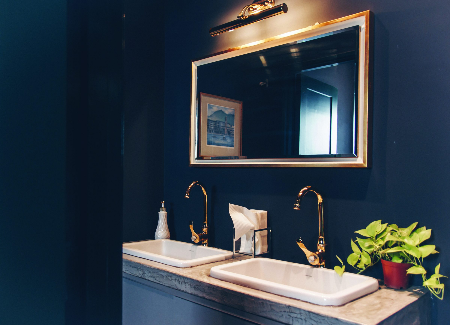
Sunlit Bathrooms: Inspirational Modern Washrooms Drenched in Natural Light
Friday, November 20, 2020
In the words of the American author Annie Dillard: "There is a muscular energy in sunlight corresponding to the spiritual energy of wind."—and since nothing paints a space quite like natural light does, we rounded up the most inspiring washrooms from recent memory to help you find ways of incorporating a generous window into your bathroom.
Augmented Shadows
 Interior design by: Bo Design
Interior design by: Bo Design
[gallery size="medium" ids="58660,58658,58657,58656,58653,58652" orderby="rand"]
Violet Tone
 Interior design by: ID Industries
Interior design by: ID Industries
Sky Blue
 Interior design by: Space In Design
Interior design by: Space In Design
[gallery columns="2" size="large" ids="58547,58546"]
[gallery columns="2" size="large" ids="58691,58692"]
Sea Green
 Interior design by: A Piece of Art
Interior design by: A Piece of Art
 Interior design by: A Piece of Art
Interior design by: A Piece of Art
 Interior design by: SQFT Space Design Management
Interior design by: SQFT Space Design Management
Sunny Yellow
 Interior design by: Gusto Design & Build
Interior design by: Gusto Design & Build
 Interior design by: Gusto Design & Build
Interior design by: Gusto Design & Build
 Interior design by: Hoe & Yin Design Studio
Interior design by: Hoe & Yin Design Studio
Golden Tangerine
 Interior design by: Design Integra
Interior design by: Design Integra
Brick Red
[gallery columns="2" size="medium" ids="58567,58568"] Interior design by: SNG Conceptwerke
Interior design by: SNG Conceptwerke
Pristine White
[gallery columns="2" size="medium" ids="58699,58700"] Interior design by: Regal Violet
Interior design by: Regal Violet
 Interior design by: PSQ
Interior design by: PSQ
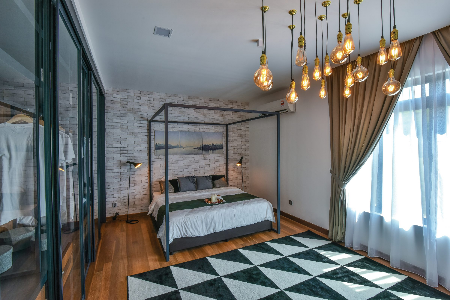
4 Bedroom Styles To Inspire You
Friday, November 20, 2020
Undecided as to whether you find comfort in simplicity, or pine for the ornate antiquities of times past? This summary of common bedroom styles will point you in the right direction.
It takes a highly proficient mind-reader to accurately determine the kind of decorative style that appeals to any individual - and while the most seasoned practitioners of interior design may be able to guess your preferences from a few brief interactions, there is no better judge of one’s own position on the spectrum of order and chaos than the self.
While the less private areas of a home may feature a décor to impress, the bedroom is largely a concern for the occupant - so before settling on your choice of furniture and materials for the bedroom, take a look at this introduction to the most common styles of décor and decide on which speaks to you the most.
Industrial Chic
 Interior design by: Homlux Interior Furnishing
Interior design by: Homlux Interior Furnishing
Some personalities gravitate towards ornate classicism for the grandeur, and others find minimalism appealing for the sake of simplicity – but the aesthetics of industrial style appeals to those who seek a lightweight décor imbued with aged sophistication. As with the pictured bedroom decorated by Homlux Interior Furnishing, a bedroom can be made industrial as a whole – with a strict reliance on materials commonly found in places of work, or a more eclectic décor can be formed with a sprinkling of a few bare light bulbs hanging by their wires, pieces of patinated metals, and stretches of exposed brickwork.
Mod Pop
 Interior design by: Casa Indah Design
Interior design by: Casa Indah Design
It goes without saying that the neutral palette dominates most interiors in the present age, but an over-reliance on the popular colour scheme may result in a sterile and impersonal décor. Rather than completely adhering to the confines of the neutral palette, designers and homeowners tend to agree that bedrooms should be canvases for expressions of personality.
 Interior design by: Casa Indah Design
Interior design by: Casa Indah Design
The pictured bedroom is saturated with neutral hues in adherence to modern convention, but the space is marked out as belonging to a youthful urbanite with vibrant splashes of yellow – presented in well-lit box niches against the subtle background of the walls.
 Interior design by: Casa Indah Design
Interior design by: Casa Indah Design
Contemporary Elegance
 Interior design by: Surface R
Interior design by: Surface R
Between the overstuffed upholstery of tradition and the bare-bones designs of minimalism lies the modern definition of luxury - as depicted in cosy bedspreads, plush curtains, and thick mattresses of high-end hotel rooms. In the pictured bedroom, Surface R demonstrates the kind of elegant results to be expected with a focus on comfort.
 Interior design by: Surface R
Interior design by: Surface R
The neutral-coloured décor is made inviting by saturation in rich textiles and brought to opulent heights with an abundance of reflective surfaces, darkly-lacquered wood, and strategically placed lighting fixtures to soften the straight lines and stark edges of modern design.
 Interior design by: Surface R
Interior design by: Surface R
Tip: Keeping the colours subtle and letting the fuzzy textures speak for themselves gets you the comfort, while dark wood and reflective metals provide the elegance.
 Interior design by: Surface R
Interior design by: Surface R
Countryside Charm
 Interior design by: JCS Design Project
Interior design by: JCS Design Project
There are few substitutes for the exquisite and romantic qualities of classicism as a style of interior decoration — largely as it entails a dependence on ornate furnishings that have been passed over by the masses in favour of more affordable and mass-produced offerings, resulting in classical furnishings being considered more valuable due to the relative scarcity of historically accurate designs. As in the pictured bedroom decorated by the JCS Design Project, when combined with soft colours, delicate fabrics, and floral motifs, the result is a feminine décor that speaks of wealth in the quaint serenity of the countryside.
 Interior design by: JCS Design Project
Interior design by: JCS Design Project
Tip: Classical furnishings are just as versatile as those of the modern variety: surround reproductions with decorative details to reinforce a traditional décor or draw attention to authentic pieces by keeping the scene clear.
 Interior design by: JCS Design Project
Interior design by: JCS Design Project
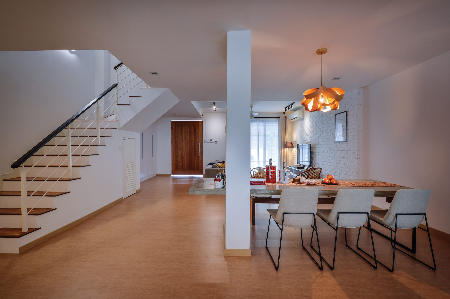
4 Ways to Use a Bench in the Dining Room
Friday, November 20, 2020
Create more space with a bench at the dining table and camouflage the arrangement with these tips.
You may have deliberately sought out a bench as a novel form of seating, or you might already possess a bench needing new purpose—either way, incorporating a bench into your dining arrangement could do more than free up some space. A bench helps to create a casual and intimate atmosphere for meals, and in place of two side chairs, takes up significantly less space. The extra floor space can then go towards greater clearance around the dining table, providing generous elbow room for diners, or even cabinets for additional storage options. If you are faced with an especially compact dining space, read on, as you may find one or two practical ideas for slipping a bench into your dining arrangement.
Island Ally
 Interior design by: Yong Studio
Interior design by: Yong Studio
Having found an available wall against which to set your dining arrangement, your next concern would be to ensure the furnishings complement the surroundings. In the pictured home decorated by Yong Studio, the bench is composed from wood that is similar in shade and grain to the floor of the kitchen. This exercise in unification is applied to the other components of the dining arrangement: the table features unobtrusive legs of minimalist design, while the material of its surface is echoed on the other side of the wall in a diminutive shelf, and in the background, with the kitchen island.
 Interior design by: Yong Studio
Interior design by: Yong Studio
Luxury Lines
As benches typically entail the absence of a back, the natural impulse in dealing with a bench would be to place it alongside a wall for back support. The wall-hugging arrangement, however, does more than free up space: beyond the practical consideration of ergonomics, the linear arrangement demonstrated by Surface R takes advantage of the Helmholtz illusion—a concept popularly applied in fashion to skew the perception of body contours. Just as with waistlines, the array of straight lines makes the pictured dining space seem wider and brings the furniture arrangement into golden proportions with the long and narrow space.
 Interior design by: Surface R
Interior design by: Surface R
Tip: The Golden Ratio is one of the few aesthetic rules, if not the only one, that governs everything from the composition of art to the distribution of leaves along a branch. To form the most visually appealing composition possible, divide the length of a rectangle by the width and you should arrive at a figure approaching the Golden Ratio (φ = 1.618).
 Interior design by: Surface R
Interior design by: Surface R
Divide & Conquer
 Interior design by: Jashen Interior Design
Interior design by: Jashen Interior Design
In tighter quarters, the placement of a dining surface against the wall is often necessary to preserve enough space for comfortably manoeuvring around the arrangement. In such a configuration, the substitution of two side chairs for a single bench frees up even more space, but requires that the bench be pulled out when needed and stowed when not in use. As Jashen Interior Design demonstrates with the pictured home, a wall bisecting the open layout is utilised as a background for the dining arrangement, with the bench tucked between the table legs to leave enough width for a walkway.
 Interior design by: Jashen Interior Design
Interior design by: Jashen Interior Design
 Interior design by: Jashen Interior Design
Interior design by: Jashen Interior Design
Focal Feature
 Interior design by: Jashen Interior Design
Interior design by: Jashen Interior Design
The open layout entailing fewer bisecting walls by definition, you may be hard-pressed to find a wall-hugging spot for your bench-augmented dining arrangement. If you find no free walls available, there exists the possibility for creative expression with a built-up partition. Without a readily available wall in the pictured open layout, Jashen Interior Design incorporates the bench side of this dining arrangement into a false wall built largely to serve as a decorative feature and primary focal point for the space. To keep the divider from overwhelming the open layout, a sizable portion of the wall is rendered reflective.
 Interior design by: Jashen Interior Design
Interior design by: Jashen Interior Design
Tip: While projecting walls may detract from the spaciousness of an open layout, the up-side is that any interruptions to the open layout you design will automatically become a point of focus in the scene and another available plane to embellish with messages or functional additions.
 Interior design by: Jashen Interior Design
Interior design by: Jashen Interior Design
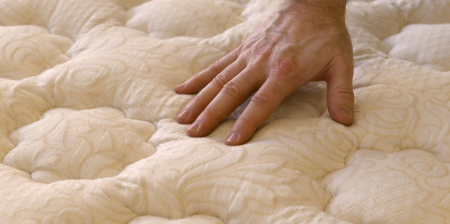
Perfect Mattress: 3 Key Tips to Buy The Ideal Mattress
Friday, November 20, 2020
All of us desire a good night's sleep. Here's where choosing the right mattress can help ensure a serene slumber all night long. When you're getting a new bed, it's crucial to invest in a high quality mattress. As we spend a third of lives sleeping, a suitable mattress will help you sleep better and thus improve your physical, mental and emotional well-being. Here are some tips to arm yourself with when you go shopping for a new mattress. 1 Test for comfort and support Make sure that the surface is both comfortable and supportive of your spine and posture. This means your spine should be in its natural curvature while you lie down flat on the bed. Have someone put his or her hand behind the small of your back. If the person's hand can move easily in the back without any gaps, the mattress is suitable for your posture. If there is a gap in between, the mattress is too hard and not supporting your back properly. If the person cannot get his or hand under your back, the mattress is too soft which causes your back to round up. Also lie on your side and stomach and examine if it's comfortable for you. Always take your time when shopping for a new mattress. 2 Find a mattress that suits your sleep style
How do you sleep? Some of us like sleeping on the back, some can only fall asleep when they are turned to one side and there are others who sleep soundly on their stomach. Your sleeping style is an essential factor when choosing the right kind of mattress.
2 Find a mattress that suits your sleep style
How do you sleep? Some of us like sleeping on the back, some can only fall asleep when they are turned to one side and there are others who sleep soundly on their stomach. Your sleeping style is an essential factor when choosing the right kind of mattress.
 For side sleepers: Get a soft or plush sleeping surface. With extra cushioning, you can prevent pressure-induced discomfort in your shoulders and hips. Plush mattresses offer extra comfort and plush support without the need for additional pillowtop padding.
For back sleepers: Opt for firm or extra firm mattresses as these help to support your back. Firm mattresses generally have a flatter top with no additional padding. Some of them also come with a firm edge support.
For stomach sleepers: Go for a slightly firmer surface so that your spine is properly aligned.
For those who with a combination of sleep styles: You may want to select something that is neither too firm nor too soft so it gives you the flexibility to support your different positions.
3 Consider your sleeping partner
Movements and motion transfers are something to consider if you share your bed with another person. You definitely don't want a mattress that bounces and shakes each time your partner roll to the side or gets up from the bed. Memory foam mattress can help to isolate movements to one side of the bed. You can also go for a hybrid of springs and foam as they usually come with transitional foam that alleviates motion.
For side sleepers: Get a soft or plush sleeping surface. With extra cushioning, you can prevent pressure-induced discomfort in your shoulders and hips. Plush mattresses offer extra comfort and plush support without the need for additional pillowtop padding.
For back sleepers: Opt for firm or extra firm mattresses as these help to support your back. Firm mattresses generally have a flatter top with no additional padding. Some of them also come with a firm edge support.
For stomach sleepers: Go for a slightly firmer surface so that your spine is properly aligned.
For those who with a combination of sleep styles: You may want to select something that is neither too firm nor too soft so it gives you the flexibility to support your different positions.
3 Consider your sleeping partner
Movements and motion transfers are something to consider if you share your bed with another person. You definitely don't want a mattress that bounces and shakes each time your partner roll to the side or gets up from the bed. Memory foam mattress can help to isolate movements to one side of the bed. You can also go for a hybrid of springs and foam as they usually come with transitional foam that alleviates motion.
 Check out our Top 5 Mattress Brands in 2018 post for more ideas.
Check out our Top 5 Mattress Brands in 2018 post for more ideas.
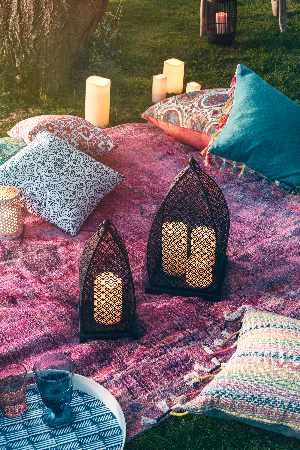
Styling Your Outdoor Spaces With Colourful Accessories
Friday, November 20, 2020
Elevate your outdoor space from a mere extension of the living room to a spot of magical potential with colourful add-ons.
Even when subjected to unpredictable weather conditions and wilful sprawls of greenery, the outdoors is just as viable a canvas for creative expression as the interior – and a home would be profoundly incomplete without an inviting yard or patio to extend living areas. If you have the outdoor space to spare, you may be thinking of providing an alternative to lounging indoors by setting aside a patch of grass or floor and adding furniture to it. Appointing your lawn with furnishings in white may be the strongest initial compulsion, but if you want to imbue your outdoor hangout with some semblance of colour, we have some ideas on how to make that happen.
Bright Nights
 Image Credit: Lights4Fun
Image Credit: Lights4Fun
A standard seating arrangement is a sufficiently practical consideration for providing a place to relax, but a certain measure of magic is necessary to make an outdoor space captivating. To dress a space as though it was transported from the realm of fantasy, consider pairing a boldly coloured rug with fairy lights strung over tree branches to mimic the stars of the night sky.
 Image Credit: Lights4Fun
Image Credit: Lights4Fun
Through both the mystical quality of floating illumination and the striking contrast of bold colours against a natural backdrop, the result is that even the most temporary of lounge spaces are elevated to enigmatic heights.
Bold Fun
 Image Credit: Carpetright
Image Credit: Carpetright
Other than surrealist landscapes born of imagination, few visual compositions are as striking as a product of human hands throwing boldly saturated colours against the verdant green of Mother Nature’s work. The contrast is perhaps as much thematic as it is about colour or shade – the same effect can be achieved with everything from a decorative sculpture to a practical arrangement of furniture.
 Image Credit: Carpetright
Image Credit: Carpetright
With a background of green grass, the stage is set for a stunning contrast to be made with brightly coloured furniture, decorations, or accessories to facilitate entertainment in your outdoor space.
 Image Credit: Carpetright
Image Credit: Carpetright
Tip: Put against the background of a lawn, nearly any manufactured object is instantly made worthy of attention – thanks to the subtle difference in natural or artificial colours and the obvious disparity in theme.
 Image Credit: Carpetright
Image Credit: Carpetright
Pastel Pretty
 Image Credit : Annie Sloan
Image Credit : Annie Sloan
There is an undeniably distinct relationship between pastel shades and rural settings, perhaps due to the prevalent sight of sun-bleached colours in provincial landscapes. Despite the fact that most people now live in urban areas, the association between pastel colours and the serenity of the countryside has moved from a feature of some people’s memories to a cultural trope that is recognisable even to those born and raised exclusively in cities. Selecting architectural finishes, furniture, or decorations in pastel shades, reinforces a rural theme in the yard and immediately transports anyone who rests there to a simpler time and place.
 Image Credit : Annie Sloan
Image Credit : Annie Sloan
Tip: A rural theme consists of more than just pastel shades – consider mimicking the weathering effects of the elements, then embellish the space with greenery and pale fabrics.
Natural Hues
 Image Credit: Annabel James
Image Credit: Annabel James
Bright splashes of colour do not necessarily need to come from products injected with dyes or coated in pigments – after all, Mother Nature is the single most prolific artist around. As can be observed in any place where foliage is given free reign, Nature tends to utilise all the visible colours of the light spectrum, and every definable shade in between, in the formation of flower petals.
 Image Credit: Annabel James
Image Credit: Annabel James
While entailing a greater degree of care and maintenance than a manufactured piece of furniture or decoration, there are few sources of colour as powerful or authentic as a bed of vibrant flowers.
 Image Credit: Annabel James
Image Credit: Annabel James
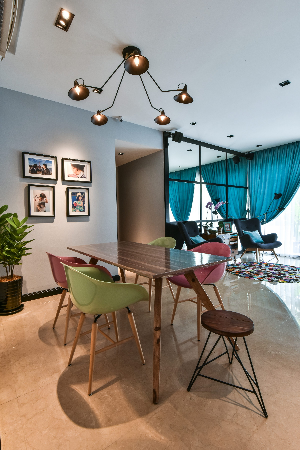
How to Select the Best Dining Table for Your Dining Room
Friday, November 20, 2020
The dining table is most often the central feature of dining spaces, contributing the most towards the décor by virtue of their size - which makes their selection all the more crucial.
The dining room is probably the one part of a home that sees the most people at any time - and whether people are just passing through or sitting down for meals, the table will have an impact on how diners perceive the space, the home, and the homeowner. As the selection of dining room furniture will likely be an event that does not occur very often, we wanted you to be as informed as possible before you set out on your journey towards your new dining table.
Material
 Interior design by: Viincology
Interior design by: Viincology
The kind of material that your dining table is made out of will have an effect on its lifespan and its appearance. Long-lasting materials such as hardwoods, metals, tempered glass, stone, and even mould-injected plastics are preferred for dining tables that are expected to endure many years of heavy use. Conversely, lightweight or flat-pack furniture composed of veneered wood composites such as plywood or fibreboard are made with mobility and affordability in mind, these materials are preferred for short-term arrangements by virtue of their being easier to pack and transport by design.
 Interior design by: Viincology
Interior design by: Viincology
Lightweight composite materials such as plywood or fibreboard are known to be significantly less durable, as they show a tendency to warp when subjected to excessive moisture or heat. Tougher natural materials such as hardwoods and stone tend to be porous, which entail regular maintenance with coats of varnish or sealer to prevent unintended staining from everyday use.
 Interior design by: SNG Conceptwerke
Interior design by: SNG Conceptwerke
Due to their being porous and softer than metal, wooden surfaces entail a greater degree of care to ensure their longevity. Oil-based varnishes should be applied to wooden surfaces at the point of manufacture - and periodically afterwards to prevent unintentional staining. Despite the higher level of maintenance required, metal furnishings tend to rust - especially when used outdoors, while wooden furnishings take on a characteristic smoothness and polished sheen as they age.
Size
 Interior design by: Hoe & Yin Design Studio
Interior design by: Hoe & Yin Design Studio
Having too large a table surface will result in a cramped dining space, while restricting diners to a small surface leads to elbows bumping in uncomfortably close quarters. It is the recommendation of most decorators to provide each diner with around 60 to 70 centimetres (or 24 to 28 inches) of space for adequate elbow room, and around 90 centimetres to 1.3 meters (or 36 to 50 inches) between a dining table and the surrounding walls for diners to comfortably get in and out of their seats.
Shape
 Interior design by: IDS Interior Design
Interior design by: IDS Interior Design
The shape of your dining table will determine the number of diners you can host and will affect the space it occupies. While round tables are capable of accommodating a greater number of diners, they tend to appear larger in small dining spaces - the conventional rectangular dining table takes up the most space, needing long and narrow spaces to avoid appearing overly large.
 Interior design by: IDS Interior Design
Interior design by: IDS Interior Design
To calculate the number of diners appropriate for a round table: multiply the diameter of a table by the value of Pi (π: 3.14) and divide the result by the amount of space needed for each diner. Using the previously mentioned minimum of 60 centimetres (or 24 inches) of space needed per diner, a round table with a diameter of 1.5 meters can easily accommodate 7 diners, or up to 8 diners with a negligible reduction in elbow room - while a rectangular table of similar size (at 1.5 meters long) can only seat a total of 6 diners – one at each end and two along each length.
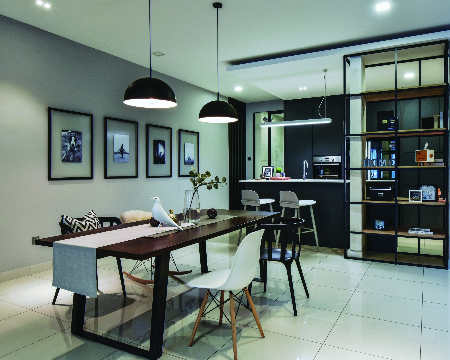
Creating a Well-Composed Dining Room
Friday, November 20, 2020
Whether you have a large formal dining hall or a small area for daily mealtimes next to the living room, here’s how to put together different interior features to ensure your dining room looks and feels good from every angle.
 Interior design by: The Roof Studio
Interior design by: The Roof Studio
Whether you’re hosting a family dinner or just getting together for a weeknight meal, the dining room is where people come together. From modern to classic, there are many ways to turn this room into a cosy space that is perfect for entertaining your guest in comfort and style. Gone are the days when you need to have matching tables and chairs at your dining table. The trend is to go for features that complement each other. If you are going for a modern look, aim for furniture that has clean lines and sturdy material. Also, make good use of tableware to pull it all together.
Palette Play
It's easier to create a well-designed dining room when you have a strong starting point to guide you - this is where having a colour palette in mind can really help you focus on the elements you can use. If you love a certain colour and have a particular hue in mind for your dining room, start with this colour.
 Interior design by: The Roof Studio
Interior design by: The Roof Studio
For example, yellows are a great way to create a bright and vibrant dining space. Start with light yellow for the walls, then add on bolder shades of complementary tones like blues. However if you are not confident about using bold colours, go for a neutral and monochrome palette, like the dining room pictured here.
Accent Pieces
Don't just stop at tables and chairs in the dining room. If you have space, accent furniture like a console or an armoire can work wonders to help create a focal point and enhance those blank walls that envelope your dining area. However, choose something that blends with your dining table.
 Interior design by: Chaplins Furniture
Interior design by: Chaplins Furniture
In this dining room, a bright blue console works beautifully to bring attention to the table. The decorative accessories and mirror above the console add a lively look to the atmosphere. The bold pendant lamps are also just the perfect features to balance off the the space.
Material Maneuver
 Interior design by: Mode Interior Style
Interior design by: Mode Interior Style
Mixing and matching different materials in the dining room can offer a dramatic yet personalised effect to your space. Balance is key, as you don't want a single material to overwhelm the rest. Also offset hard and sturdy surfaces with soft furnishing to give your space a sense of cosy warmth.
 Interior design by: Mode Interior Style
Interior design by: Mode Interior Style
In this dining room, there is a bold variety of materials ranging from solid wood and faux grass to brick-like finishes on the opposite wall. The addition of the marble-like feature wall balances off the dark-coloured surfaces. The use of wood flooring just around the dining space also helps to demarcate the space clearly.
Vibrant Variety
Another way to mix materials is through a variety of different seating and surfaces. Mix-and-match seating works well when each chair or bench is of a similar style and shape. Also think about what you use as centrepieces on your dining table.
 Wood and ratan are making a huge comeback in the dining room, but those from the lighter range are preferred. Go for a Zen effect but break from the monotony with stronger tones and textures. Interior design by: iDecorate
Wood and ratan are making a huge comeback in the dining room, but those from the lighter range are preferred. Go for a Zen effect but break from the monotony with stronger tones and textures. Interior design by: iDecorate
In this warm and neutral dining room, the woven rattan chairs bring a sense of similarity to the entire set, but if you look closely, every single piece is individual in style. To further enhance the room, a tableware set with a similar look and feel is used.
Trendy Tableware
 Interior design by: iDecorate
Interior design by: iDecorate
Finally, complete your dining room with beautiful tableware to bring everything together. When it comes to choosing a dinnerware set, the choice is usually a matter of personal taste. It’s a necessity for any table, but it also sets the mood for a meal. For example, formal china can make a momentous occasion feel even more special, while basic stoneware is a good match for a low-fuss weeknight dinner.
 Colour coordinate your tableware by having a neutral backdrop and then enhancing it with bolder tones through colourful plates, bowls, and mug. Interior design by: Dunelm
Colour coordinate your tableware by having a neutral backdrop and then enhancing it with bolder tones through colourful plates, bowls, and mug. Interior design by: Dunelm
In the example here, a white dinner set complemented by green accents bring out a nature-inspired theme that enhances the wood dining table. To add texture, fabric placemats tone down the hard surfaces and introduce a lush quality to the space.
 Interior design by: Dunelm
Interior design by: Dunelm
Article by: Lily Wong
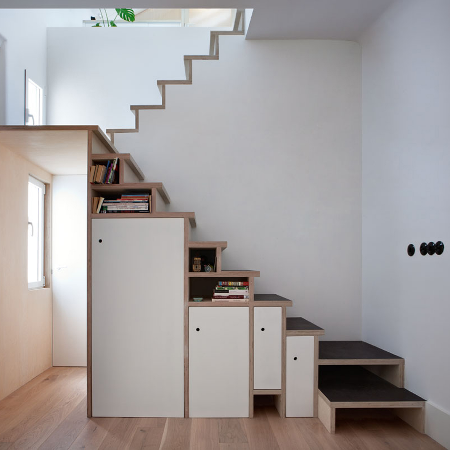
Step Storage: 7 Creative Under-Stairs Storage
Friday, November 20, 2020
The empty space under the stairs sometimes gets a bad rap on account of the many stories depicted in film that paint this potential storage space as a nest of insidious horror - or at the very least, a place of relative obscurity where things go to be forgotten. But in this modern age of urban living - where gratuitous space typically comes at a premium, we felt it be prudent to look at these spaces under the stairs in a new light, in order to discover novel ways of incorporating storage options.
Climbing Cabinetry
 Image Credit: Buj+Colón Arquitectos
Image Credit: Buj+Colón Arquitectos
In a compact space where a full-fledged staircase would have been overwhelmingly large, a lightweight stairway is formed out of progressively taller cabinets and bookshelves, with an intermediate split-level landing simplistically projecting from the top of the cabinetry. The result is deliberately left without a railing to achieve an unobtrusive stairway that is ingeniously disguised as storage.
Footwear Hideaway
 Image Credit: Post Architecture
Image Credit: Post Architecture
The act of removing one’s shoes when entering a home has transitioned from being a distinctly Asiatic custom of tradition to a practical measure in many urban homes around the world - which necessitates considerable storage fixtures to be incorporated at the entryway. The pictured shoe drawers, designed by Toronto-based Post Architecture, enable a sizable family’s worth of shoes to be neatly stowed away in the unassuming space beneath the stairs.
Stairway Stack
 Image Credit: Schemaa Architects
Image Credit: Schemaa Architects
While a stairway with a steep incline may present a formidable barrier to the upper floors, the complete use of extra space for cabinetry helps to disguise the risers and treads of the pictured loft-style staircase. To soften the gradient of the stairway, Schemaa (a Parisian architecture firm) incorporates intermediate blocks of wood to break up the high risers of the steps - resulting in a more graceful incline.
Aperitif Alcove
 Image Credit: DIY Network
Image Credit: DIY Network
An alternative to wholly dedicating the space under the stairs to storage is put forward by the DIY Network’s Watson Hawkins. The idea entails moving beyond pure storage and adding a facet of functionality to the space. In the pictured example, nearby countertops are extended to the space beneath the stairs, with cabinetry truncated at an angle to match the slope of the stairway’s carriage.
Sequestered Office
 Image Credit: Translina
Image Credit: Translina
For the majority of those who often find themselves working at a desk while at home, the extra headroom often goes to waste during those hours seated at a desk. Rather than dedicating an entire room to a home office and letting that overhead volume go unused, the pictured staircase incorporates a diminutive office space - where the lower clearance serves to neatly encapsulate the work corner.
Foyer Fixtures
 Image Credit: Minimalist Desk
Image Credit: Minimalist Desk
Walking out of the front door is a ritual that often gets repeated whenever a necessary object gets left behind - with the procedure often followed by dashes up and down the stairs to retrieve some forgotten item. The entryway often gets cluttered with catch-all containers and furniture as a result. The pictured stairway holds an ordered array of wicker baskets in niches beneath the carriage to negate the clutter and hide vital containers from sight.
Hidden Habitat
 Image Credit: Basement Remodeling
Image Credit: Basement Remodeling
Spaces deemed too small for a human to utilise can be handed over to our smaller companions instead. With their uniquely low-lying perspectives, even the smallest of burrows can shelter whole landscapes that are worlds apart from their larger environment. The pictured stairway accommodates a desk just wide enough to be used (by a human) for writing letters - with the extra headroom dedicated to wine storage, while the extra space to the side goes to one lucky quadruped.





